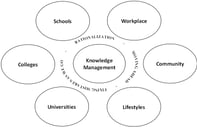Published on
The Benefits of Competency-Based Education for Adults

Competency-based education (CBE) can be adapted to many educational models, but the version that best serves the needs of adult learners is one that is online, self-paced, and asynchronous. This assertion certainly pushes the envelope of traditional learning models, but the advances in technology have made the world’s library of knowledge and skills in every discipline globally accessible—a reality that also pushes the envelope of traditional educational models. Education, especially higher education, is quickly advancing toward an environment of learning validation over traditional teaching practices and theories. This environment will be less concerned with how learners acquire their skills and knowledge than it will be with the measures used to validate that learning. The question then becomes: are these new, innovative educational models better than—or at least on par with—centuries of generally accepted teaching practices? And even if they are, are these models sustainable?
The basic premise behind competency-based education is to achieve the outcome. CBE models encourage building courses, programs, and degrees based on what knowledge and skills a student can successfully demonstrate through reliable and valid measurements. CBE lends itself more easily to asynchronous, self-paced courses and programs as it focuses on the final outcome, and not the journey that leads to the outcome. Adult students tend to be attracted to this model of education because they can see the end from the beginning. The majority of adult learners are trying to fit the enhancement of their education into a limited amount of time; few are willing to stop working or delegate family obligations in order to focus on personal educational endeavors. Asynchronous, self-paced CBE models put the learner in the drivers seat, which is a great thing for many adult learners; it promotes ownership of one’s own education. These types of CBE models do not encourage passive reception either; students who study in a CBE modeled course or program have to be independent learners. It is the student, not the instructor, who decides how he or she should prepare to demonstrate his or her understanding and skill level through high-stakes testing.
One positive aspect of Competency-Based Education is the promotion of individualized learning. A model such as CBE that promotes individualized learning while accommodating multiple learning styles and levels of engagement is certainly exciting. However, there are some tricks to making CBE models sustainable over time. Due to the outcomes-based nature of CBE, the assessment piece in the model becomes more prominent, and critical. Asynchronous, self-paced CBE models may encourage the tendency to forego seat time and skip straight to the assessment. In fact, in many formats, the assessments are the only student artifacts that contribute to the course grades. This focus on assessment will reduce the amount of time students spend doing assignments, but it also puts a great deal of responsibility on the assessment designers. The assessments in this type of course must be a very accurate survey of the domain of knowledge and skills considered essential to meeting a standard of mastery of the content.
This added layer of responsibility and precision calls for innovations in assessment design. It is very difficult to design exams tied solely to outcomes, without regard to where the knowledge and skill was acquired. This might even be considered a brand new skill set in the field of measurement and assessment. New or not, it is definitely a skill that not only takes a lot of mental agility, but also takes a fairly large shift from traditional learning cycles and assessment practices to different, broader, but more precise theories of building high-quality assessments. For many traditionally trained assessment and curriculum designers, the shift might also require a concerted effort in self-monitoring to consistently adhere to a competency-based approach. Reliance on textbooks or other learning resources to develop exams would be a violation of a CBE model. For in a CBE model, to emphasize a point made previously, the judgments about what to measure in an assessment must be based on the foundational knowledge, skills, theories, and practical applications of the discipline being assessed, as opposed to what is emphasized by a single author of a textbook or other learning resource.
Another main attraction for adult students in choosing a CBE educational model is the potential to “get credit” for life and work experience. In more traditional models, everyone generally starts at the beginning of a course and works through each activity to the end before having the opportunity to take the final exam. A CBE model respects personal experience and responsibility in learning by allowing students to select which resources, if any, they will use to prepare for the final exams. Usually this means that adults can make judgments about what to study and when to test based on their previous experience with the content. Most adult learners believe themselves to be the best judges of their knowledge and ability, and so this concept is exhilarating to them. Self-directed education can be empowering. It can also be discomfiting for a student if they overestimate their preparedness and do poorly on the assessments. For this reason, responsible self-directed CBE programs also develop resources for students to use if they choose to engage with them. Building a supportive set of learning resources ensures that students, should they choose to use them, are accessing accurate information that is aligned to the outcomes of the course and its assessments.
The most effective CBE models do not rely on a single type of assessment for a course; rather each course has at least two measurements: an objective assessment and a performance-based assessment. The most effective models are also fairly keen to disclose to the student, as much as is responsibly possible, the standards against which they will be measured and the formats of the tests themselves.
From an administrative perspective a CBE educational model opens doors to innovation in course and assessment delivery, many of which have cost-effective measures built in. Theoretically, CBE self-paced programs can be managed and delivered by fewer people and may have higher student to instructor ratios. This idea will be alarming to some, but in light of the fact that each student studies on their own time, students often get many more one-on-one interactions with their instructor. CBE-designed courses and programs are often more adaptive to a variety of learning styles, especially when backed by advanced technologies.
CBE courses and programs do require some specialized considerations. Many CBE programs are delivered totally online, which means that students and mentors or instructors rarely meet face to face. This requires students to cultivate independent learning skills. It is also requires that instructors and mentors develop strong and unique interpersonal communication skills.
Another special consideration is that it is arguably much more difficult to authenticate whether the student taking the exam or engaging with the course is actually the student who is registered for the course. Plagiarism and fraud concerns are a part of even on-ground courses and programs, but virtual learning requires specialized tools and applications in order to monitor such activities. Tools and options in this industry are improving rapidly. There is still a lot of work to be done, but the increasingly urgent need for such technologies is definitely driving advancements in this arena.
Competency-based educational models are poised to make a significant impact amid the increasing innovations and improvements going on in higher education. The CBE models are adult-friendly and cost effective. There are many institutions already using them and with great success. The concerns over rigor and quality control are real, but are starting to be addressed in functional and research-based ways. It’s an exciting time to be part of the innovation and creativity that is jumpstarting the re-structuring of higher education. Competency-based education is just the beginning.
Author Perspective: Administrator



